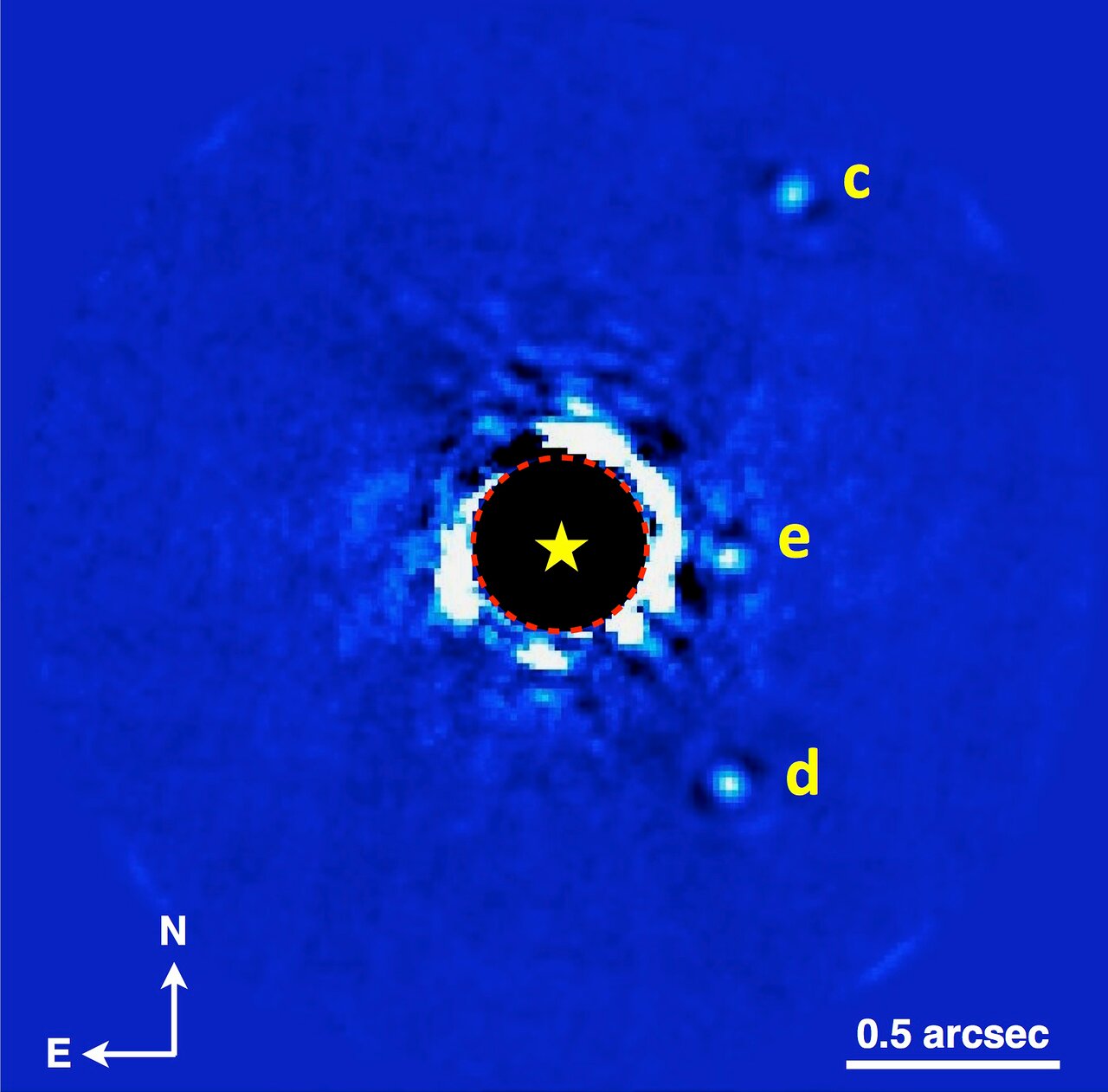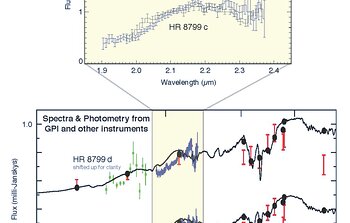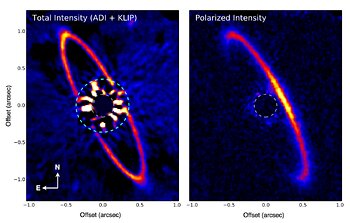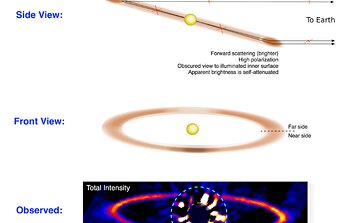The Gemini Planet Imager Produces Stunning Observations In Its First Year
January 5, 2015

Stunning exoplanet images and spectra from the first year of science operations with the Gemini Planet Imager (GPI) were featured today in a press conference at the 225th meeting of the American Astronomical Society (AAS) in Seattle, Washington. The Gemini Planet Imager GPI is an advanced instrument designed to observe the environments close to bright stars to detect and study Jupiter-like exoplanets (planets around other stars) and see protostellar material (disk, rings) that might be lurking next to the star.
Marshall Perrin (Space Telescope Science Institute), one of the instrument’s team leaders, presented a pair of recent and promising results at the press conference. He revealed some of the most detailed images and spectra ever of the multiple planet system HR 8799. His presentation also included never-seen details in the dusty ring of the young star HR 4796A. “GPI’s advanced imaging capabilities have delivered exquisite images and data,” said Perrin. “These improved views are helping us piece together what’s going on around these stars, yet also posing many new questions.”
The GPI spectra obtained for two of the planetary members of the HR 8799 system presents a challenge for astronomers. GPI team member Patrick Ingraham (Stanford University), lead the paper on HR 8799. Ingraham reports that the shape of the spectra for the two planets differ more profoundly than expected based on their similar colors, indicating significant differences between the companions. “Current atmospheric models of exoplanets cannot fully explain the subtle differences in color that GPI has revealed. We infer that it may be differences in the coverage of the clouds or their composition.” Ingraham adds, "The fact that GPI was able to extract new knowledge from these planets on the first commissioning run in such a short amount of time, and in conditions that it was not even designed to work, is a real testament to how revolutionary GPI will be to the field of exoplanets."
Perrin, who is working to understand the dusty ring around the young star HR 4796A, said that the new GPI data present an unprecedented level of detail in studies of the ring’s polarized light. “GPI not only sees the disk more clearly than previous instruments, it can also measure how polarized its light appears, which has proven crucial in under-standing its physical properties.” Specifically, the GPI measurements of the ring show it must be partially opaque, implying it is far denser and more tightly compressed than similar dust found in the outskirts of our own Solar System, which is more diffuse. The ring circling HR 4796A is about twice the diameter of the planetary orbits in our Solar System and its star about twice our Sun’s mass. “These data taken during GPI commissioning show how exquisitely well its polarization mode works for studying disks. Such observations are critical in advancing our understanding of all types and sizes of planetary systems – and ultimately how unique our own solar system might be,” said Perrin.
During the commissioning phase, the GPI team observed a variety of targets, ranging from asteroids in our solar system, to an old star near its death. Other teams of scientists have been using GPI as well and already astronomers around the world have published eight papers in peer-reviewed journals using GPI data. “This might be the most productive new instrument Gemini has ever had,” said Professor James Graham of the University of California, who leads the GPI science team and who will describe the GPI exoplanet survey (see below) in a talk scheduled at the AAS meeting on Thursday, January 8th.
The Gemini Observatory staff integrated the complex instrument into the telescope’s software and helped to characterize GPI’s performance. “Even though it’s so complicated, GPI now operates almost automatically,” said Gemini’s instrument scientist for GPI Fredrik Rantakyro. “This allows us to start routine science operations.” The instrument is now available to astronomers and their proposals are scheduled to start ob-serving in early 2015. In addition, “shared risk” observations are already underway, starting in November 2014.
The one thing GPI hasn’t done yet is discovered a new planet. “For the early tests, we concentrated on known planets or disks” said GPI PI Bruce Macintosh. Now that GPI is fully operational, the search for new planets has begun. In addition to observations by astronomers world-wide, the Gemini Planet Imager Exoplanet Survey (GPIES) will look at 600 carefully selected stars over the next few years. GPI ‘sees’ planets through the infrared light they emit when they’re young, so the GPIES team has assembled a list of the youngest and closest stars. So far the team has observed 50 stars, and analysis of the data is ongoing. Discovering a planet requires confirmation observations to distinguish a true planet orbiting the target star from a distant star that happens to sneak into GPI’s field of view - a process that could take years with previous instruments. The GPIES team found one such object in their first survey run, but GPI observations were sensitive enough to almost immediately rule it out. Macintosh said, “With GPI, we can tell almost instantly that something isn’t a planet – rather than months of uncertainty, we can get over our disappointment almost immediately. Now it’s time to find some real planets!”
About GPI/GPIES
The Gemini Planet Imager (GPI) instrument was constructed by an international collaboration led by Lawrence Livermore National Laboratory under Gemini’s supervision. The GPI Exoplanet Survey (GPIES) is the core science program to be carried out with it. GPIES is led by Bruce Macintosh, now a professor at Stanford University and James Graham, professor at the University of California at Berkeley and is designed to find young, Jupiter-like exoplanets. They survey will observe 600 young nearby stars in 890 hours over three years. Targets have been carefully selected by team members at Arizona State University, the University of Georgia, and UCLA. The core of the data processing architecture is led by Marshall Perrin of the Space Telescope Science Institute, with the core software originally written by University of Montreal, data management infrastructure from UC Berkeley and Cornell University, and contributions from all the other team institutions. The SETI institute located in California manages GPIES’s communications and public out-reach. Several teams located at the Dunlap Institute, the University of Western Ontario, the University of Chicago, the Lowell Observatory, NASA Ames, the American Museum of Natural History, University of Arizona and the University of California at San Diego and at Santa Cruz also contribute to the survey. The GPI Exoplanet Survey is supported by the NASA Origins Program NNX14AG80, the NSF AAG pro-gram, and grants from other institutions including the University of California Office of the President. Dropbox Inc. has generously provided storage space for the entire survey's archive.
More Information
See the AAS press conference featuring Marshall Perrin speaking about Gemini Planet Imager results at: http://aas.org/media-press/archived-aas-press-conference-webcasts
Click on the “Exoplanet & Host Stars II” session, Perrin is the final speaker in the session.
Contacts
Peter Michaud
pmichaud@gemini.edu
(808) 974-2510
808-936-6643
Public Information and Outreach Manager Gemini Observatory
Hilo
Hawai‘i
Marshall Perrin
mperrin@stsci.edu
(410) 507-5483
STScI
James R. Graham
rg@berkeley.edu
(510) 926-9820
University of California Berkeley



